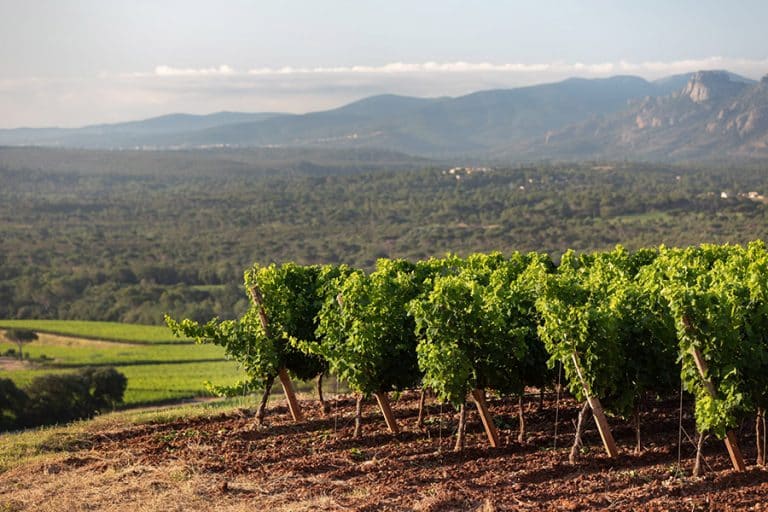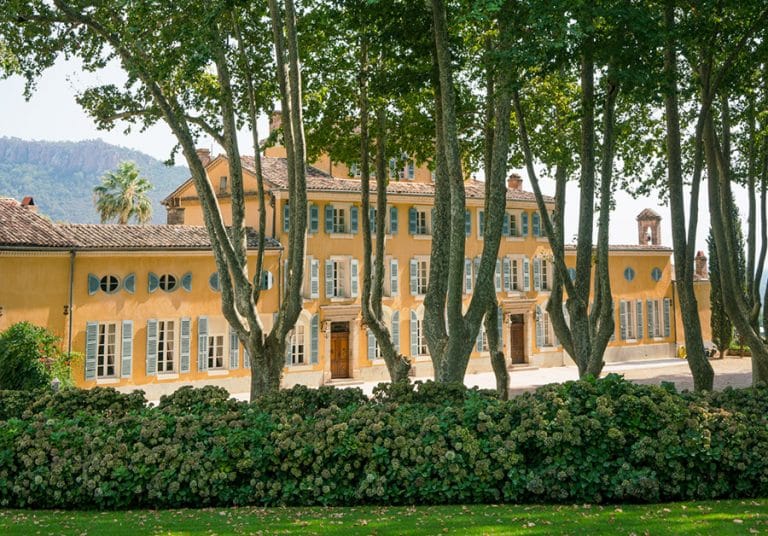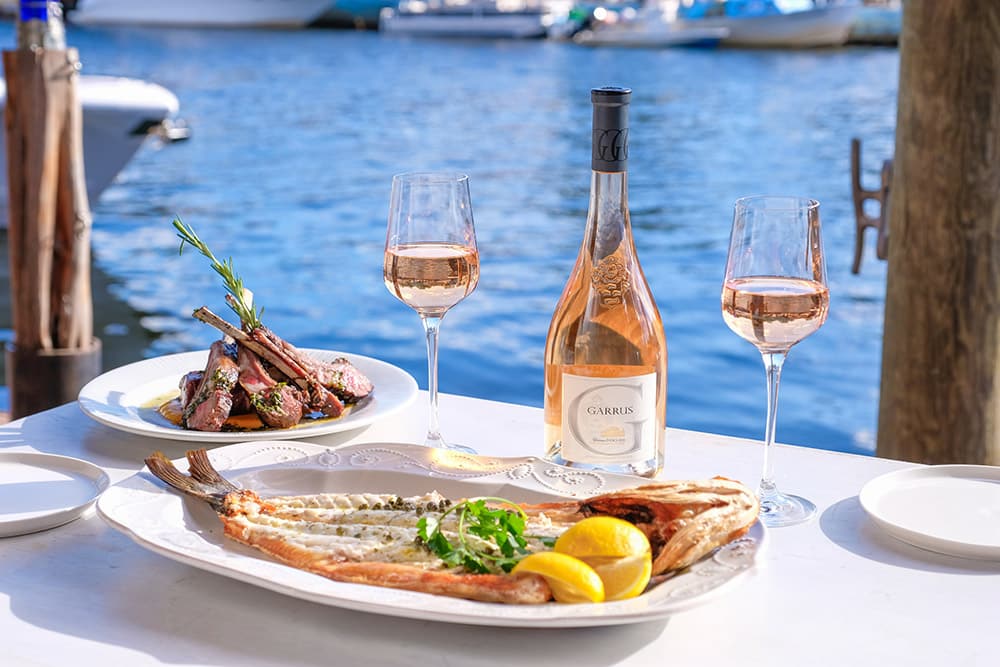The Way is Rosé
It’s difficult to explain the rise of rosé, but associations can be drawn from the international tourism boom that Provence, France, experienced beginning in the 1990s.
Provence gained fame for its relaxed lifestyle, quaint markets, enchanting villages, wafting aromas of lavender and rosemary, renowned cuisine – and its easy-drinking rosé. Tourists began associating rosé with all things Provence, and between a jar of honey and a bottle of rosé, most wanted the latter – and they didn’t want to be disappointed. Pressure began to build for wine makers to produce more serious rosé, and this brought many talented winemakers to Provence.
A simpler explanation for the rise of rosé would be Château d’Esclans.
This revitalized estate in the heart of Provence forced the wine industry to pay attention when it opened in 2006 and released Garrus – the most exclusive rosé in the world. This impressive and concentrated rosé rivals any top white wine or prestige Champagne, evidenced by its global popularity with connoisseurs of fine wine and its 2019 awarding of 96 points from the famous wine journalist, James Suckling. Decanter’s Jane Anson graded Garrus at 96 points in 2019; Matthew Jukes awarded it a perfect 20/20; Tasting Book‘s Markus del Monego provided a rating of 97/100; and Andreas Larsson from Tasted provided a 95/100. Headed by Sacha Lichine, Château d’Esclans remains the model for success in Provence, also producing Whispering Angel and Rock Angel, two of the most popular rosé wines on the market.
Château d’Esclans is located on an exceptional site, in the center of the Département of the Var, built on elevated land near the Gorges de Pennafort, some 15 miles to the north-west of the ancient Roman city of Fréjus on the Mediterranean coast. The original Château was given by the Comte de Provence to Gérard De Villeneuve, in 1201, of which now only parts of the cellar structure remain. The current Château, inspired in design by a Tuscan villa, was built during the mid-19th century.

Ownership of the property traded hands until 1994, when managers of a Swedish pension fund bought the land and saw an opportunity to begin commercial grape production. Much of the grapes grown were sold to other winemakers in the area, only a tiny amount of which went into winemaking efforts at the Château. The estate gradually gained a reputation for producing quality grapes, and speculation began on how it might impact the French wine industry. With the acquisition of the property by Lichine in 2006, that aspiration became a reality.
Born in Bordeaux, raised in New York City, and schooled in New England, Lichine possessed a keen understanding of wine, from seed to sale on a global scale. Lichine’s family pedigree includes his own father Alexis Lichine, who himself was legendary in the wine world for his definitive book, The Wines of France. However, Lichine was no lightweight in the wine world before purchasing the château in Provence. He began working at his family’s former property, Château Prieuré Lichine and Château Lascombes during the summers of his youth from working the vines to dressing and selling the final product in the estate’s retail shop. Lichine has also worked as a Sommelier at Anthony’s Pier 4 Restaurant in Boston and has worked at and managed wine distribution companies worldwide.
Further enhancing the winemaking efforts, Lichine collaborated with master winemaker Patrick Léon to become his Consulting Oenologist. After purchasing the estate, Lichine and Léon commenced a careful restoration at the Château, replacing much of the antiquated wine-making machinery with the latest cutting-edge equipment. This resulted in new, state-of-the-art processes and procedures that improved everything from picking the grapes to bottling the wine, expediting the aim of creating the best rosé in the world.

“The quality of red and white whites has been improved with technology and innovation, why can’t we improve the quality of rosé?” Lichine asked, “Why not make a serious rosé?”
Château d’Esclans houses 660 acres of land, of which more than 100 acres are planted with vines grown in clay-limestone soil that receives plenty of warmth and sun. The primary grape grown on the property is Grenache (about 60%) followed by Vermentino. The Grenache vines offer more concentrated flavor and grow on an elevated slope, and the Grenache grapes that are selected and picked from this prized parcel are used exclusively to produce Garrus.
Temperature, according to Lichine, is the most important factor throughout the entire process of rosé winemaking. The cooling system alone required an investment of over a million euros, but Lichine explains that it allows “lots of experimentation with aromas, flavors, and taste.” The cold temperatures also slow everything down and keep the wine fresh.
Attention to temperature begins with special dry ice pellets that are used to hold carefully-selected grapes, picked by hand at dawn to ensure cooler harvesting temperatures. Sophisticated temperature-control measures ensure maximum ripeness and yield the best possible flavor. After the bunches have been picked and de-stemmed, the grapes undergo a delicate hand sorting and then visit a vibrating table where a state-of-the-art optical sorter scans the grapes.
“Rosé is probably, wine-wise, the most difficult wine that I’ve ever had to make, technically,” Lichine often says. The results, however, are well worth the complexities of the process.

Related Stories
Planworthy Journeys with KEY.co in 2024
Allow Jet Linx and our Elevated Lifestyle partner KEY.co to take you on a planworthy journey. Adventure awaits with KEY.co’s 2024 top travel destinations and custom-crafted itineraries.
READ MORE
Elevated Lifestyle Holiday Gift Guide
Elevate your gift-giving this year with our annual Elevated Lifestyle Holiday Gift Guide.
READ MORE
A Seamless Journey Awaits You: Meet Our Elevated Lifestyle Transportation Partners
We know that every step of your journey matters, and our ground transportation partners ensure that every mile traveled is nothing short of extraordinary.
READ MORE
Related Stories
Planworthy Journeys with KEY.co in 2024
Allow Jet Linx and our Elevated Lifestyle partner KEY.co to take you on a planworthy journey. Adventure awaits with KEY.co’s 2024 top travel destinations and custom-crafted itineraries.
READ MORE
Elevated Lifestyle Holiday Gift Guide
Elevate your gift-giving this year with our annual Elevated Lifestyle Holiday Gift Guide.
READ MORE
A Seamless Journey Awaits You: Meet Our Elevated Lifestyle Transportation Partners
We know that every step of your journey matters, and our ground transportation partners ensure that every mile traveled is nothing short of extraordinary.
READ MORE



Contact Us